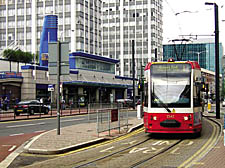|
|
 |
| |

The tram system which runs in Croydon |
Off your trolley if you support Ken’s trams
The Cross River Tram project will cause chaos writes David Hyde-Harrison
EVERY effort must be made to reject the Cross River Tram proposal. London’s main problem is insufficient roads for cars not rail lines for trains. No investigation of traffic dislocation has taken place. The leaflets contain no information concerning roads closed to cars or buses, or the serious delays to cross traffic. There is no opportunity to vote against the scheme; one only has first and second choice, from this they will falsely conclude that the tram is popular. The forms are very expensively produced at our expense, and give virtually no information concerning costs and the increases in council tax.
There is already a Tube from Camden via Euston to Waterloo. Few people realise, and I am not including mainline trains, that there are as many electric underground railways into London as there are roads, yet more people travel by bus let alone the cars and trucks.
To reduce the number of roads by more than 15 per cent besides holding up cross traffic is a serious error. In order to increase the electric trains, because infrequent trams that are 150ft (45m) long carrying 300 people should be called trains. The location of the depot for the storage of 50 trams possibly in Kentish town is unknown.
There will be chaos with no advantage during the installation which is estimated as four years, with completion in 2016.
The 10 per cent of tram track on or crossing roads in the Croydon scheme produced traffic chaos, when being installed, for much longer than four years. Ninety per cent of Croydon’s track is on park land compared to the Cross River Tram proposal which has 100 per cent on roads with services underneath.
There has seldom in the past been a clear run with no road works during the last 20 years for the full run. Road repairs are nearly always emergencies. When the services need repair the trams will have to stop running sometimes for months at a time. Rails are a silly old fashioned idea and we pulled the old tramlines up because they were a nuisance. They kill cyclists who get forced onto them until they wobble off their bikes. The Croydon trams have not killed many people but they have killed more people proportionally to the number of vehicles.
Old trams had incredibly noisy steel wheels on steel tracks.
Mainline railway trains have incredibly powerful buffers at terminus stations because when the lines are wet or have leaves on they sometimes take a quarter of a mile to stop.
I guess the trams will have rubber on the wheels but they will still be less good at braking in emergencies than cheap motor cars and will be noisier. Will all the trees have to be cut down when a serious accident occurs because of fallen leaves? The trams are designed to have trolley bus arms. So there will be many more poles on the pavement and wires in the sky to spoil tourist’s photos of historic buildings. Why on earth do they need old fashioned rails? They don’t; it is simply a scheme designed to block motorists. Delivery to roadside shops will become a nightmare and many shops will have to close.
Trolley buses could skirt delivery lorries and holes in the road. If Eversholt Street is used it will not be wide enough to allow any traffic.
The buses which currently use this cross river route can turn off and therefore provide a greater variety of routes. The cars of course can do the same, and can shorten their journey length and time compared to public transport.
The trams will increase global warming by using coal to make their electricity, a fuel ten times as dirty as petrol. The electricity may have had to travel 50 miles to reach the overhead wires and had to change voltages on the way and travel in the overhead wires at low voltages for safety reasons which consumes a great deal of energy.
It is true the road is cleaner but the world is dirtier. The trams will be slower than the electric trains, which can be easily speeded up with automatic mobile telephone communication and track improvements.
The future development of transport in a hundred years time will be seriously held up and the trams will have to be scrapped in 30 years time.
With the coming of the universal ownership of computerised motor cars which even Ken Livingstone who failed his driving test will be able to drive.
– See letters
|
 |
|
 |
|